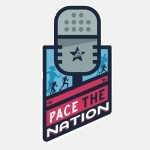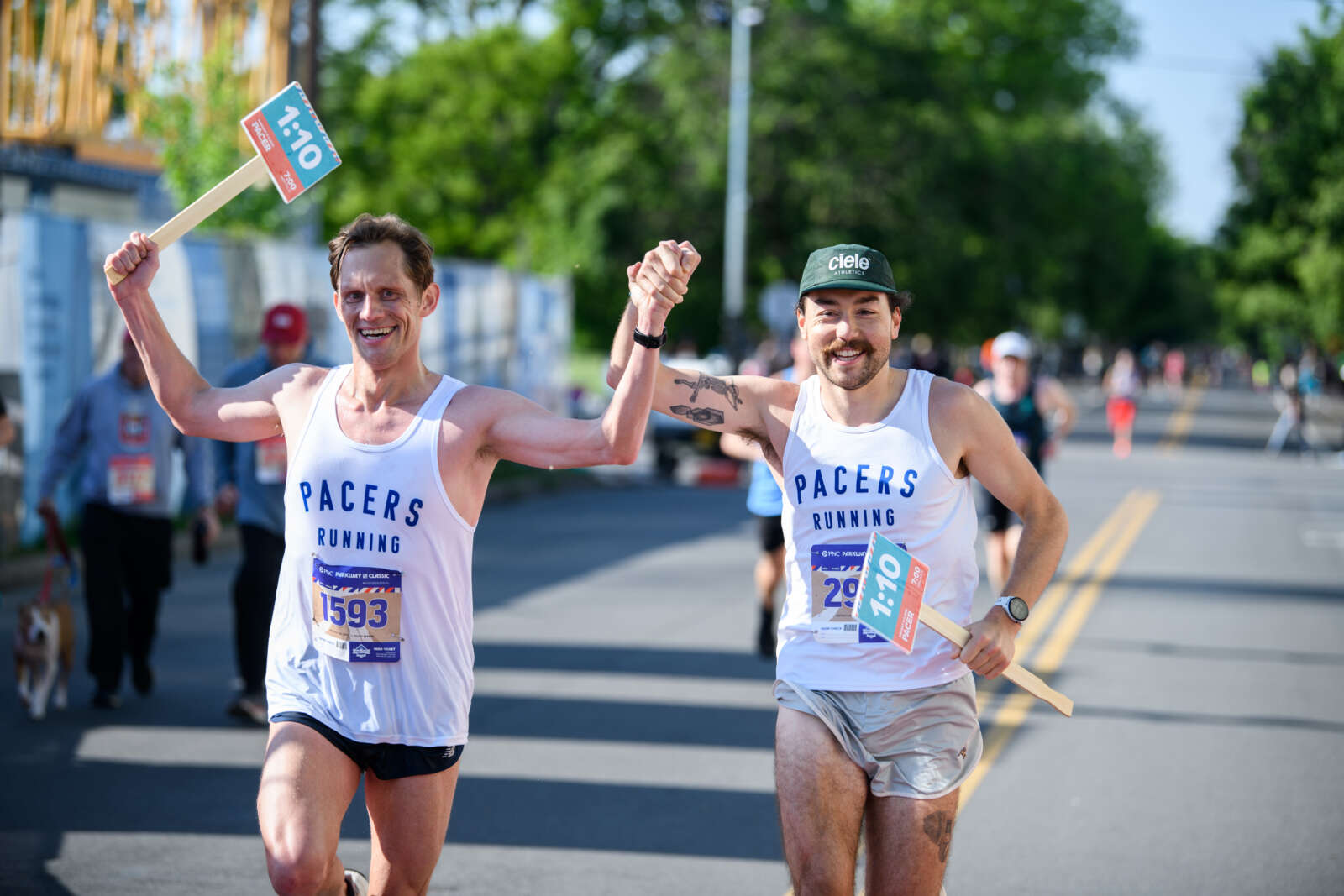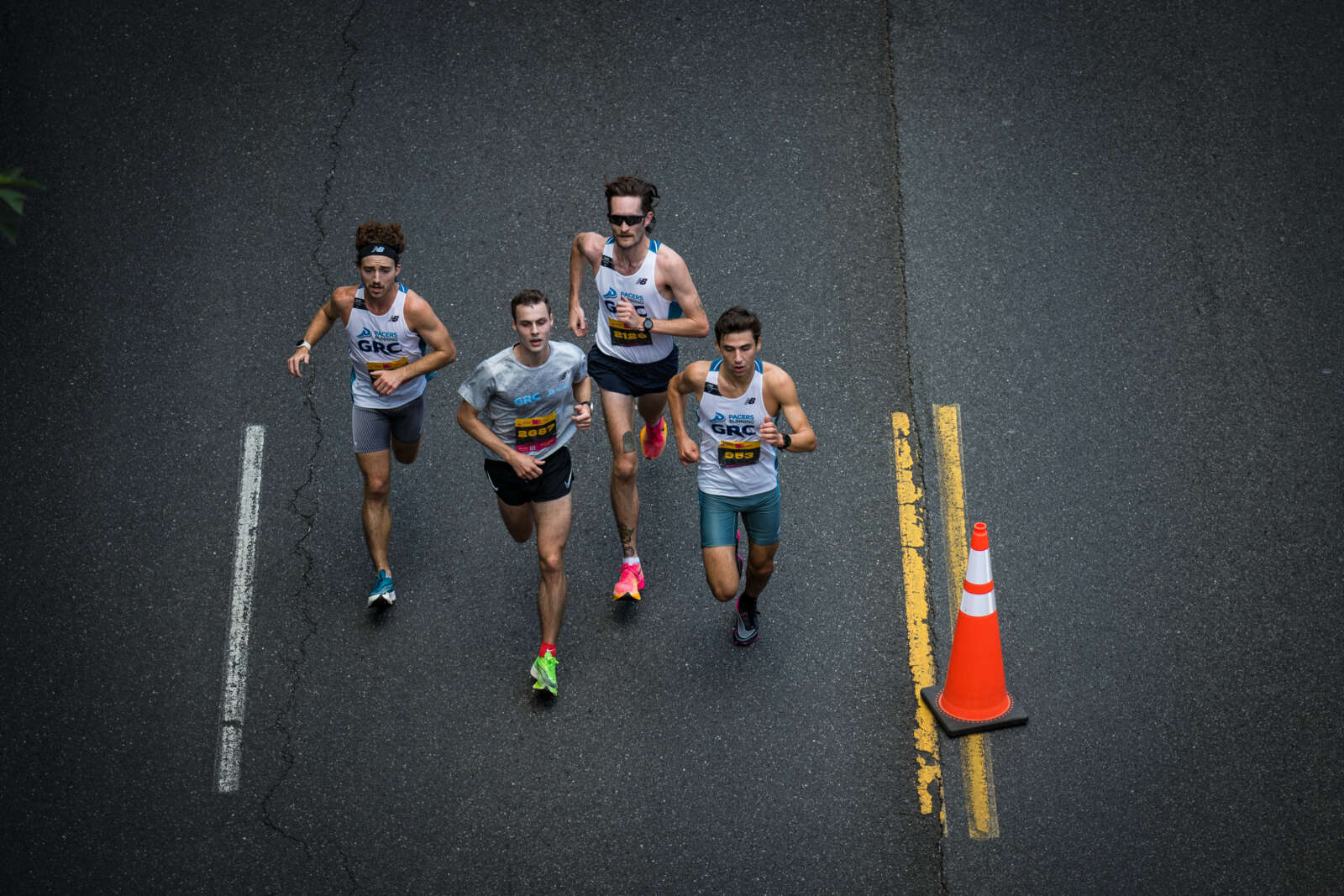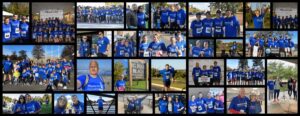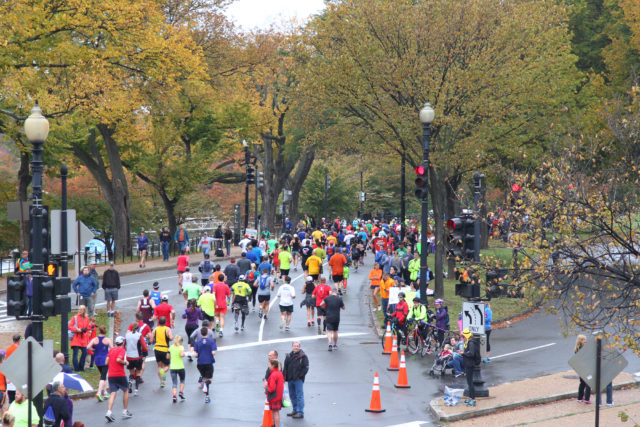
Running the Straight and Narrow
As I write this, Marine Corps Marathon training is reaching its zenith. The calendar holds just a few more weeks for hard training.
And by the time you read this, you’ll be tapering. It could even be race week, your thoughts shifting to smaller details.
It used to be about how far and fast you’d run on Sunday. Now it’s about little things on race day like how to hold your gels and what shoes to wear. It’s about the defining question of the 41st People’s Marathon: Uber or Lyft?
How the course got this way
But I’m still hung up on a detail from last year, a detail that, when the howitzer fired, was as far away from my mind as the finish line: tangents.
It’s a post-GPS watch realization for me — and my run last year at MCM proved it — that I do a very poor job minimizing the distance I cover on the course.
In other words I’m realizing how important it is to study more than where the hills are and where they aren’t. After all the time invested in training, I should also be studying the turns and curves, amassing the knowledge — or at least the awareness — of how to only run 26.2 miles.
I think it’s one of the craziest, most overlooked realities that marathoners contend with: that the marathon, this absurdly long race, at a minimum, is 26.2 miles. In reality most of us run longer than that, leaving precious seconds — even minutes — out on the asphalt.
When a course is designed according to USA Track and Field guidelines — making it eligible to be a Boston Marathon qualifier, say — it has to be measured along the shortest possible route that a runner could follow.
Picture yourself looking out at a long road ahead of you. The course would appear to be everything inside the cones and natural barriers on the road. Except the course is really a straight line. It’s like a track lane unfurling ahead of you; sometimes, even, the sidewalk is the track equivalent of the rail. Think about the distance you’re adding if you are in the middle or even on the opposite side of the road.
Hear some more
If you watched the Olympic marathons this summer or raced the recent Chicago Marathon, you might have noticed a line on the course that wasn’t for cars or bikes. It was there to remove the guesswork involved in running the shortest route. At MCM, though, as is the case with most races, the line is invisible and you need to develop a sense of where it is.
Why am I obsessing so much about this? Well, for me, as I get older, running a personal best in the marathon will require something of a perfect run; running roughly .3 extra miles, as I did last year, isn’t exactly helping my cause.
But I’m also thinking about Barbara Benson, 45, of Springfield. Racing under her maiden name, Gallagher, Benson missed qualifying for the Boston Marathon by 1 second, yet her iPhone data shows she covered more than 27 miles! Certainly with just a little more precision navigating the course she could have punched her ticket. [Good news: Benson ended up notching a Boston qualifier in November, not long after MCM, at the Richmond Marathon.]
That said, it’s also important to understand what our GPS data is really telling us.
Racing in the GPS era
For this story we asked readers to send us MCM GPS data to see if running longer than 26.2 miles was a common experience. As it happened, Benson had the longest measurement, though everyone who wrote to us had GPS readouts of at least 26.5 miles.
However, some of the responses purported suspicion that the course was longer than advertised. One runner wrote to me saying that the 2013 MCM course was nearly half a mile long, foiling a personal best.
I wrote back, hinting at my view: “That’s what I had too on my watch (in 2015). Do you have any thoughts on what makes it tough to run the tangents right at MCM? I noticed the extra distance I ran seemed to be in the first eight miles when the roads are really wide.”
Back came a resistant reply: “I think the course is just plain long by half a mile. This was the first year they changed the course and I think it was mismeasured. I can understand a tenth of a mile or two but almost half a mile difference tells me it is too long.”
This is why your favorite toy — your GPS watch — can be a nightmare for race directors. For as quickly as runners upload their race data and comb through it, in come the emails crying, “long course.”
The thing is, GPS watches are not perfect at measuring distance. They are impressively accurate, but all it takes is one close look at where your watch thinks you ran, zooming in on the map, to see the flaws. Mine, for instance, thinks I ran last year’s MCM in the Potomac River en route to the Key Bridge. And while there are some impressive algorithms that help smooth these types of issues out, your watch, especially in a race as long as the marathon, typically overestimates how far you ran.
That said, sometimes a long GPS reading is a clue that the course really was long. RunWashington contributor Maggie Lloyd experienced this in June at the Sunburst Marathon, in South Bend, Ind.
But this is a rare case. If it’s a USATF-certified course and your GPS data indicates you ran long, tangents are the much more likely enemy.
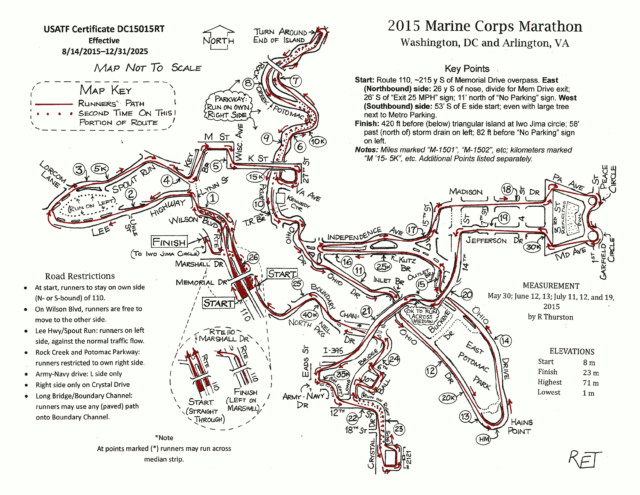
This is an argument that becomes a lot more persuasive when you look into everything that goes into making sure a course is accurately measured by our region’s USATF-approved course certifier Bob Thurston. He has certified MCM, through all of its changes and tweaks, since 1983.
A race director who wants to get a course certified begins with two options. They can work with a USATF-certified course measurer to lay down a proposed route, or they can just try to measure it themselves and work up a map.
Thurston is the one who confirms that the proposed course is legit. His job, in a sense, is to put the course to the test: finalizing start and finish positions, pinpointing mile markers, and ultimately producing a highly detailed hand-drawn map.
In certifying a course, Thurston’s work begins by creating what is known in the trade as a certified calibration course. This is measured with a steel tape — a tape measure — and it needs to be measured twice and be at least 300 meters long. After the calibration course is laid down, Thurston gets on his bicycle, attached to which is his most essential tool: his Jones Counter. It’s like an odometer, but much more accurate. This device counts the revolutions of the wheel and, as you ride, “keeps turning over numbers,” Thurston says.
Thurston will ride his calibration course at least four times. He takes those counts and uses them to determine how many counts on the Jones Counter equal a kilometer or mile. With this calculation, and the knowledge that his bike and Jones Counter is working as they should, he then goes out and rides the course, measuring it at least twice following the shortest possible route. It’s a requirement that there can only be a very small difference between the two measurements.
So, as you can see, Thurston’s method — the work of the certifier — is pretty scrupulous. Where mistakes do happen, though, is when the course is being set up.
Thurston, like all certifiers, will provide race organizers with very detailed instructions for how to set up the course according to his certified design. It’s then up them to execute it.
In South Bend, when Lloyd and thousands of marathoners were positive that they had run .4 miles extra, the race director initially sent out an email laying out the tangent argument that’s in this article. He then had to backtrack and apologize after discovering that the course actually had run long due to a setup error.
But before you wonder if this could happen at MCM, keep the following in mind. One, MCM is literally executed as a military operation. On top of that, Thurston rides the course early race morning to make sure everything is marked right.
Another thing: Typically I think it tends to be obvious when a course is short. But when a course is long, one flag is that, if you’re keying off of the mile markers, you should have one exceptionally long mile in there. Meanwhile, afterward, it probably won’t be a few of your friends wondering if the course was long. It’s more likely to be a mutiny spreading like wildfire across your social media feeds.
The midpack problem
You know, I have no excuse for running long. I lined up last year in the first few rows and ran most of the race solo. I can’t recall a point where it would have made more sense to ignore the tangents to save energy by drafting in a pack. And my path was certainly never impeded.
But if you are a midpack runner, or even a quarterpack runner, here’s where it gets tricky, as described by Thurston on the podcast Pace the Nation:
“Most people,” he said, “are not able — even they were thinking about it — they’re not able to run the same course that we have to measure. Like, if you’re a front runner, maybe you could, but you’re more likely to follow the vehicle in front of you or whoever is leading. You might, but you’re going to have to go to all the tangents…
[But] if you’re in the middle of the pack, [the tangent] is not available because you’d have to run over people; you’d get knocked down.”
Early in her race, Benson, rather than following tangents, was focused on finding clear pathways through the crowds as she passed people. She was basically zigzagging across the road, not at all running in a straight line.
Mark Lent averaged just under 10-minute miles last year for his official race time while recording 26.9 miles on his watch. He blamed the added distance on “corral climbers … people not respecting the starting corrals.”
Lent lined up in the 4:15-4:30 corral, a proper reflection of his finishing time. But “The early miles,” he wrote, “were congested with many runners who were running slower than the corral they lined up in, which is a common experience in every race I’ve participated.”
By 7 miles, the crowds started clearing up for Lent. By mile 10, he was surrounded by people running the same pace as him. He had broken free.
Good tangent running could have at least helped him for the rest of the race.
How it’s done
To gather some tips on how to run tangents correctly, I called Jim Dahlem of Chevy Chase. Dahlem’s watch, when he crossed the MCM finish line last year, read 26.36. Personally, I’d be thrilled with that, but Dahlem wasn’t pleased.
“I’m a tangent person,” he said. “I never run longer than I have to.”
Dahlem’s tangent obsession goes back to his native St. Louis. New to racing, he got involved with a 5k in his neighborhood, and the job of measuring the course went to him. Dahlem went to work laying out a course. He did some biking, jogging, used Google Maps. It was pretty casual.
But then the course certifier came in and showed him how it’s done.
“Once they described it to me” — that you had to measure the shortest route — “it made sense,” he said. “But before then I had never even thought about it.”
Here’s some advice, then, from someone who now thinks about this stuff all the time.
Say you make a sharp right hand turn and see that the next turn is left.
“A lot of people will go immediately to the opposite side of the road instead of angling across from the corner to the corner,” Dahlem explained. You want to run diagonally across the street.
What about wide roads with twists and turns on the MCM course like Spout Run and Rock Creek Parkway?
“You really need to watch the tangent and try to run from the inside curve and angle across to the next inside curve. You’ve got to really run against the way most people are running,” Dahlem said.
He added: “It would be a straight line from the inside of one curve to the inside of the other. But then around each curve you would be hugging towards the inside. Every one of those turns you can lose distance.”
Dahlem admitted that it’s tough to memorize all the turns in the marathon. “The key at that point,” he said, “is just looking ahead and seeing if I can see whether the runners are curving left or right at the intersection, and then, once I see that, start angling towards that corner.”
I also called the MCM course certifier himself, Thurston, who offered this advice:
“Pay attention,” he said. “Look at the course, and as you go certain places, depending on the conditions, you might want to break off from the crowd and save some steps. Can you get over to the curb without a lot of effort? A lot of this depends on the width of the road and the amount of turning. If it’s a big, wide road and it turns more than a few degrees, you’re going to save a lot by going to that shortest available side.”
Pretend, Thurston said, that you are on a road that has really high curves and trying to stretch a string from the start to finish.
“That’s pretty much where you want to run.”
Do your homework
What has helped me even more than Dahlem’s and Thurston’s explanations has been going directly to the source.
If you go to the USATF website, you can find Thurston listed in a database of course certifiers. There, you can look through all the maps and accompanying coded paperwork that he has produced throughout the years for everything from local road miles to marathons.
When I pulled up Thurston’s MCM map from last year, I noticed, looking closely, that he includes the route you should run in his drawing. That allowed me to see where I went wrong — for example, hugging the left of the Lee Highway hill when I should have been angling over to the right; or all the times I was on the wrong side of the road or staying too long in the middle.
Here’s an assignment, then. Before race day, don’t just look at the official MCM course map; look at Thurston’s. Get your cheat sheet and see if you can bring your GPS reading down on this year’s Safetrack-adjusted course closer to 26.2. That should be the goal. And the incentive, if anything else, is that you can celebrate your finish that much sooner.
This article originally appeared in the Winter 2016/2017 issue of RunWashington
Recent Stories
Looking for our race calendar? Click here Submit races here or shop local for running gear
James W. Foley Freedom Run
Inspired by the moral courage of freelance journalist James Foley, the mission of the nonprofit Foley Foundation is to secure the freedom of Americans held captive abroad unjustly by terrorist organizations or rogue states, and to promote journalist safety.
The
Kensington 8K Race
Since 1994, the Kensington 8K Race has been a favorite DC area fall race – a fun, fast event with beauty, challenge, and excitement. Run it this year on Saturday, September 21, 2024!
The 8K distance is $39, with a


